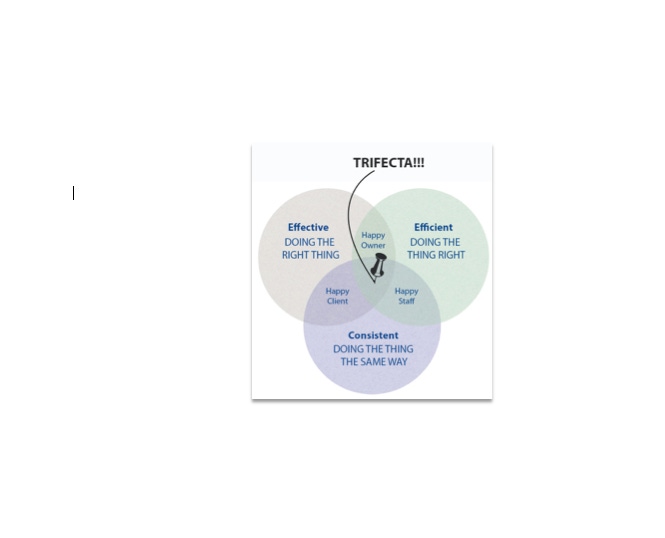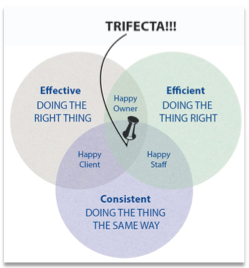What’s the first adjective that comes to mind to describe excellence in MSP services delivery? If you’re a client, the word could be "effective. If you’re the IT technician, the word might be "consistent." As an MSP owner, you might say "efficient."
September 14, 2015

By Kaseya Guest Blog 1
 Quick! What’s the first adjective that comes to mind to describe excellence in MSP services delivery?
Quick! What’s the first adjective that comes to mind to describe excellence in MSP services delivery?
If you’re a client, the word could be “effective.” Effective service delivery means that you are getting your desired result. If your MSP delivers services effectively, you’re a happy camper.
If you’re the IT technician, the word might be “consistent.” Consistency measures the regularity of the use of resources to reach a stated end. So, processes that are consistent (and predictable) make life sweeter when you’re the one driving the IT dashboard.
As an MSP owner, you might say “efficient.” Since efficiency indicates how well you use resources, more efficient services delivery usually means more profit at the end of the day.
Of course, since you’re not a one-dimensional cardboard character, you know you need all three for real, sustainable success as an MSP. How do you win the trifecta of effective, efficient and consistent service delivery?
Philosophy
To quote the great philosopher Yoda: “Do or do not. There is no try.”
In all seriousness, you have to have a plan and a process to keep you on track. The plan doesn’t need to take weeks or months to put into place. It can be a simple spreadsheet or a single sheet of paper where you:
Identify the most important elements of service delivery that need to be done well. (See my suggestions in the Best Practices section below).
Grade your performance for each element with a simple 0-3 rating system, reflecting whether each element is being delivered effectively, efficiently and/or consistently. Be honest.
Prioritize these elements and list the skills, processes and technology you need in order to score 3 out of 3 for each one. Luckily, the elements are usually very interdependent–so an improvement in one element often improves others, as well.
Carve out time on the calendar, as appropriate, to get these action items done. Do them. Or don’t do them. There is no try.
Set up a regular review cycle to measure your progress and adjust as needed. (Rinse and repeat.)
Best Practices
At times, every interaction with a client seems like a critical interaction. But in reality, there are elements of service delivery that are foundational – get these right and you’ve almost won the trifecta already.
Here are my suggestions for elements of service delivery that are essential:
1. Policies: Stop managing machines and start managing policies and machine groups. Successful MSPs create, update and apply policies to groups of machines, managing exceptions while keeping systems in compliance of predetermined conditions.
Aggregate your management tasks and think how you can apply changes by machine group (for example, Exchange servers) across your entire customer base. Focusing on exceptions rather than each machine streamlines IT systems management, eliminating the repetition typically associated with one-machine-at-a-time maintenance while ensuring consistent IT service across environments
2. Patching: Good patching practices are essential to the health, performance and security of any IT infrastructure you manage. Patches need to be updated completely, routinely and in a timely fashion. Leverage technology to make patch updates as automatic as possible.
Again, as with policies, reduce the number of patch policies to those that work for most of your clients’ needs. Then create additional policies to handle the exceptions as needed.
3. Standardization: As I mentioned at the top of the article, consistent and predictable processes are a soothing balm to the IT soul. But consistency is best achieved if the IT environments you manage have been standardized–including hardware, servers, desktop, edge devices, OSes, versioning, etc. Every deviation in this infrastructure map creates the need for workarounds, policy exceptions, asynchronized patch and update scheduling, etc.
By standardizing on the systems you manage, you simplify your workload and create time and space to enable your team, your clients and your business to grow in effectiveness and efficiency.
Not all clients are willing or able to standardize their infrastructure on your time table. You can handle this in several ways:
Charge a premium for managing non-standard systems to fund the extra policies and time required to manage them.
Create a mutually agreeable migration plan that will, over time, standardize the client’s infrastructures. Of course, you can also charge a premium for non-standard servers, etc., during the transition period.
Walk away from the business.
Technology
Your technology is the heartbeat of your IT services delivery. The technologies you adopt must support your goal to deliver consistent, efficient and effective IT services. It’s critical that the technology supports your policies, such as who gets access to which networks, computers, capabilities; how often passwords are changed; reporting requirements; etc.
And these policies should trigger automated routines and alerts to enable more efficient and effective monitoring and management. Servers that are out of compliance can be automatically detected so your techs can remediate. If backups don’t perform successfully, the system can alert your techs–or even reboot the server automatically. You get the picture.
Recent Enterprise Management Associates’ research indicates that automation can reduce the time to manage patch and software upgrades by 50% on average. This data supports Kaseya’s research with our client base. Kaseya customers see a steep increase in IT technician efficiencies, with 60% reporting at least doubling, with many quadrupling, the devices-per-tech ratio. In addition, almost half reduce IT management cost by 25% or more. Finally, they report increased end-user satisfaction, with 80% reporting 4+ levels of end-user satisfaction (on a 1-5 scale).
To learn the pros and cons of technology options out there–from point solutions to freeware to integrated systems–download the MSP Guide to Growth: Efficiency, Tools and Best Practices.
Efficient. Effective. Consistent.
You can get along with one or two of these characteristics for a while. But to have a thriving MSP for the long term, you need all three, all the time.
So do. And win the trifecta.
Joining Kaseya in 2012, Miguel Lopez brings over 20 years of experience to his role as Senior Technical Director. In this position, he consults daily with Managed Service Providers (MSPs) to help them solve their clients’ business problems with technology solutions. Prior to joining Kaseya, Miguel served as the director of consulting services for All Covered, a nationwide technology services company that is a division of Konica Minolta Business Solutions USA Inc. In 2008, All Covered acquired NetCor Technologies, a leading MSP that Miguel founded and managed since 1997. NetCor specialized in serving highly regulated industries such as healthcare, CPAs, law firms and retail companies.
You May Also Like
